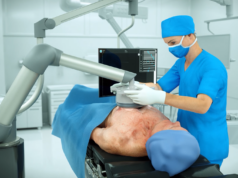 Physicians at Mount Sinai Health System (New York, USA) have developed a mobile application to expedite and enhance care for ST-segment elevation myocardial infarction (STEMI) patients. The app—STEMIcathAID—developed by Mount Sinai’s interventional cardiologists, Emergency Department physicians, and nursing team, improves communication among doctors, nurses, and the clinical command centre so that patients can get more rapid care to improve outcomes.
Physicians at Mount Sinai Health System (New York, USA) have developed a mobile application to expedite and enhance care for ST-segment elevation myocardial infarction (STEMI) patients. The app—STEMIcathAID—developed by Mount Sinai’s interventional cardiologists, Emergency Department physicians, and nursing team, improves communication among doctors, nurses, and the clinical command centre so that patients can get more rapid care to improve outcomes.
STEMIcathAID launched on Tuesday, 20 July, and involves Mount Sinai Queens, a community hospital in the borough’s Astoria section, and The Mount Sinai Hospital’s Cardiac Catheterization Lab on Manhattan’s Upper East Side.
Mount Sinai Queens does not have a cath lab and nearly 150 patients every year with STEMI are transferred from the Mount Sinai Queens Emergency Department to The Mount Sinai Hospital’s cath lab for percutaneous coronary intervention (PCI). The road distance between the two hospitals is roughly six miles, but heavy traffic can create challenges for STEMI patients. The app aims to expedite this process.
When a patient arrives at the Queens emergency room with chest pain and is suspected to have a STEMI, the physician opens the STEMIcathAID app and taps a “raise alarm” button. They perform an electrocardiogram (EKG) and upload the results along with the patient’s basic information. The app sends an instant notification to the on-call interventional cardiology physician at The Mount Sinai Hospital and to the transfer centre. The on-call physician reviews the information and decides if the patient needs a cath lab procedure. If so, the on-call cardiac catheterisation team receives an immediate notification through the app. All cardiac team members log in and begin communicating with the team in Queens through a HIPAA-compliant chat or video call. As the patient gets moved to the ambulance and driven to The Mount Sinai Hospital, the cath lab team can track their progress through the app while urgently preparing the room and equipment for the emergency procedure.
Without the app, doctors and nurses must rely on multiple telephone calls between hospitals and the EKG cannot be read immediately by the Manhattan cardiologist.
Annapoorna Kini, director of the Cardiac Catheterization Lab at The Mount Sinai Hospital, is behind this initiative. She designed the application and worked with an app developer to help realise the need for and launch STEMIcathAID.
“This is a unique platform that will make the standard of care of STEMI patients more predictable, efficient, and urgent. With enhanced communication, we can more reliably activate the cath lab and prepare for the patient’s arrival at the very start of treatment in the emergency room. By getting to the cath lab faster, patients will have fewer complications from the heart attack and may be discharged earlier from the hospital,” says Kini. “Our app, modelled on the American Heart Association’s recommendation of rapid cath lab-first treatment, can serve as a model for change throughout the USA.”
The app was used for the first time on a case involving a 46-year-old man who arrived at the Queens emergency room with chest pain and was going into cardiac shock. He was transferred to The Mount Sinai Hospital’s cath lab within 20 minutes through rush-hour traffic where doctors successfully completed his stenting procedure. Kini says this app saved a half-hour of critical time. As a result the patient had no complications and left the hospital in 48 hours.
“The single platform that communicates with all necessary departments allows the Emergency Department to reduce the number of calls and communication devices that the doctors and nurses typically need to use for these cardiac patients. These cases typically would require multiple phone calls to coordinate between the emergency room, cardiology, EMS, and the transfer services,” says Matthew Bai, assistant director of Emergency Medicine at Mount Sinai Queens. “The app has the potential to increase efficiency and reduce the time it takes to get to the cath lab for improved patient care.”
The app also prompts nurses and physicians to give discharged patients the proper information about medication, diet, and follow-up care, including the post-heart attack recommendations of the American Heart Association. This should help keep patients from needing to return to the hospital.










